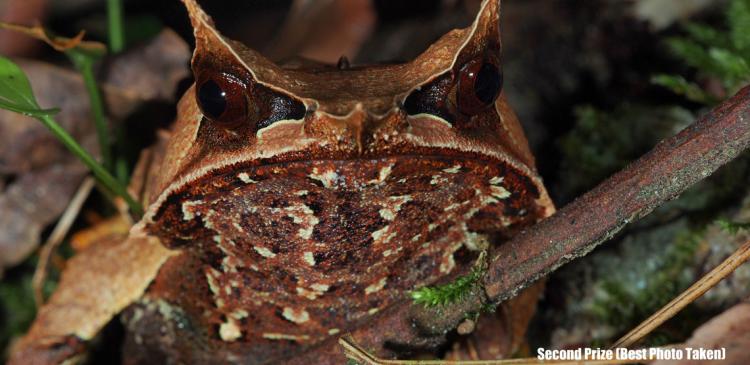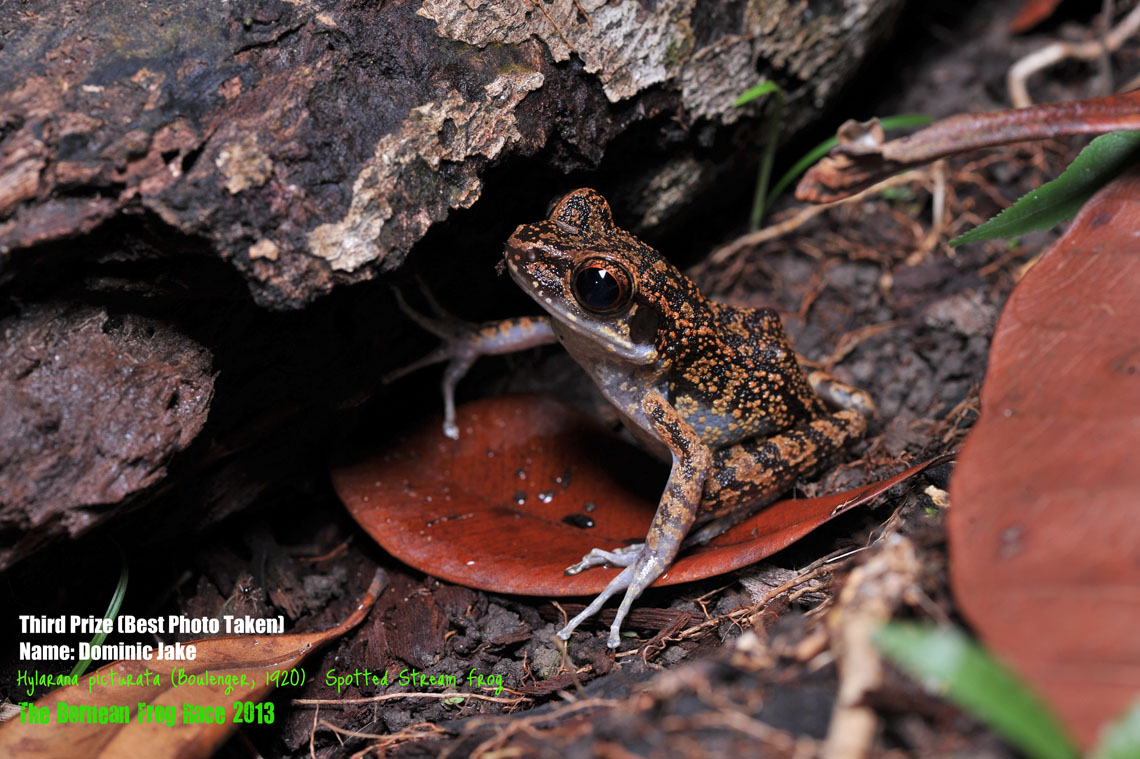First Prize - The White-lipped frog
The first prize was awarded to Philip Chen Zhao Ching for his photo of the White-lipped frog (Hylarana raniceps - Peters, 1871).
The Hylarana raniceps is a small green frog, sometimes with brown back. The snout is long and pointed and finger and toe tips bear adhesive disks, while the underside of the thigh may be reddish. This species lives in lowland primary and good secondary rainforest habitats and reproduces in ponds, intermittant streams, or quiet side pools of streams. Usually small groups of males call from twigs and vegetation 0.5 to 1.5 m above the ground. Occasionally congregations of many males can be seen at reproduction sites. The tadpoles are unique. They have dark markings and shining red gills on light brown to yellow background. This might be the least shy tadpole of all species and can be seen even during daytime. It is presumably poisonous (note patches of skin glands). (Information taken from Frogs of Borneo website - see link below)
The 2nd prize was awarded to Methos Phang for the photo of the Bornean Horned Frog (Megophrys nasuta - Schlegel, 1858)
Megophrys nasuta is a common species in the lowlands of Borneo, but also occurs up to montane levels. It is a stocky frog with arms and legs that appear almost too slender and weak for that size of a frog. The head is broader than the body and relatively flat. Snout tip and upper eyelids bear triangular skin projections. two pairs of thin folds run down the back. Males call at the late day hours or at dusk. Also they announce upcoming rainfalls and can call energetically during intense rain. M. nasuta is a forest floor ambush hunter waiting for big insects, snails and possibly other frogs coming within reach of its tongue. It will rely on its camouflage and will sit and cower when approached.
All species of the genera Megophrys and Xenophrys have typical tadpoles that cannot be confused with any other tadpoles: The mouth labia are enlarged and form a funnel. In resting position it is slightly folded and the corners point upwards. When the tadpoles swims up to the water surface, the funnel spreads out and is used as a structure that channels water with small particles (pollen, durst, bacteria) to the mouth. The small particles are filtered from the water in the gill chamber. The tadpole of nasuta appears darker in pigmentation than the other Megophrys or Xenophrys species. (Information taken from Frogs of Borneo website - see link below)
The 3rd prize was awarded to Dominic Jake for his photo of The Spotted Stream Frog (Hylarana picturata - Boulenger, 1920)
H. picturata is a species associated with lowland streams. It has a yellow to orange spots but lacks a stripe along the trunk. Males usually are around 40 mm, females can reach almost 70 mm snout vent length. The tadpoles are black in appearance with a blueish shimmer. The tail fin is moderately high the tail itself is long. The Tail fin bears many skin glands that become visible under appropriate light. The iris has a red ring around the pupilla.
Tadpoles live in stagnant or slow moving water. We frequently found them im stream side pools with accumulations of leaf litter. These tadpoles specialize in using the spaces in stacks of leaf litter. They hide during the day, but may come out and surface during the night. At night they are much paler in coloration.
Hylarana picturata and H. signata are members of a species group that is not yet well understood. We expect that the group on the island of Borneo comprises more than one species. Currently the two species are diagnosed by being striped (signata) or spotted (picturata); also their tadpoles may be indistinguishable in the field. (Information taken from Frogs of Borneo website - see link below)
BACKGROUND TO THE BORNEAN FROG RACE
On 27th of April, the Bornean Frog Race was held at the Kubah National Park in Sarawak, Malaysia where conservationists in several countries highlighted the threatened status of amphibians via a series of activities aimed at arousing public awareness of the world’s disappearing amphibians.
Amphibians comprise some 6,771 species, and living representatives include frogs, salamanders and caecilians. From a conservation standpoint, it is remarkable that a large proportion of the world’s amphibians- a third of the known species, are recognized as being under threat.
A “frog race”, included talks on amphibians and their conservation, exhibits of sights and sounds. The event was open to the general public, jointly-organised by the Institute of Biodiversity and Environmental Conservation, UNIMAS and Sarawak Forestry Corporation (SFC).
The race itself was modeled after the annually-held and highly successful “Bird Race”, where participants went on one or more trails at the Serapi foothills within Kubah National Park, for a period of 2 hours, and returning with digital images of amphibians. This is the 2nd year of the event. The first was in 2012, at Camp Permai, Santubong.
FOR MORE INFORMATION
Indraneil Das, D.Phil., Professor
Institute of Biodiversity and Environmental Conservation
Universiti Malaysia Sarawak
94300 Kota Samarahan,
Sarawak, Malaysia
E-mail: [email protected]
Office: +60 82 582996
Mobile: +60 128301208; +60 194821208
Website: www.frogsofborneo.org
Lab page: http://theherpetofaunalbiologygroup.weebly.com/index.html





